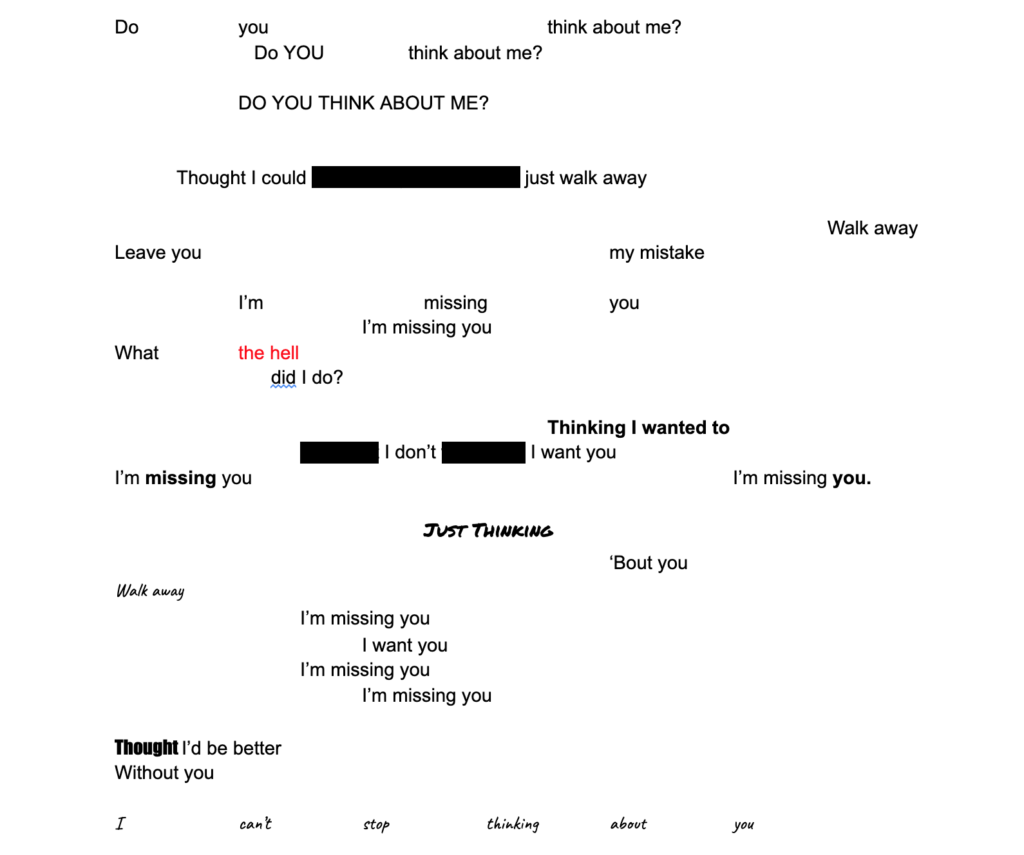Emma Ruch
Zong! By M. NourbeSe Philip focuses on the ship Zong and the neglection and mistreatment Captain Luke Collingwood had towards the enslaved Africans on the ship. The poems in Zong! are to tribute and memorializing the death of the enslaved people who lost their lives on the ship. The format of the poems leads to confusion and frustration as the reader is putting it together. This is because Philip’s takes the idea as a whole and breaks it down by separating words, using fragments of words, filling the page with blank spaces, and using repetition of specific words throughout the page. This specific format pulls emotion out of the reader by trying to get them to understand what is trying to be said. It is almost as if there is a full article of someone speaking about a topic, and Philip pulls out words and letters from the text to focus on the importance of what is trying to be said. The reason this could be frustrating is that the reader is going to have a hard time piecing together what is being said because the message is not always clear.
Knowing the fact that the ship was overcrowded and had about double the amount of desired people for the size of the ship, there began to be a need for a water supply. This causes the Captain to think of many ways they can reduce the amount of water being consumed, so there is enough for everyone on the ship. With a lack of water and resources, Collingwood decided that it would be best to massacre more than 130 Africans on the ship. The text states, “Captain Luke Collingwood is of the belief that if the African slaves on board die a natural death, the owners of the ship will have to bear the cost, but if they were ‘thrown alive into the sea, it would be the loss of the underwriters” (Philips – 189). This quote inherently reveals the cause for the ‘need’ to massacre the innocent people, so the British workers on the ship can still be provided with basic needs. Collingwood tries to cover up his actions of this gruesome action by saying the enslaved people have died due to natural causes of being on the ship. Being a white male he had the advantage to get away with these unforgivable acts stated in the text as, “The ship’s owners begin legal action against their insurers to recover their loss. A jury finds the insurers liable and orders them to compensate the ship’s owners for their loss — their murdered slaves” (Philips- 189). This proves that the jury did not take into consideration the whole case because the idea of it does not seem logical.
Zong #1 focuses on both the ideas above (the format of the specific poem and the need for water) put into a poem. Philip’s writes Zong #1 almost as a cry for help. Reading through this poem it is almost as reading a person struggling to ask for water. This constant need for water is based on the water storage from the ship, and the stutter of words and sentences. Although throughout the whole poem is letters spread out, towards the end it is clear that the words “water” and “want of water” are being stated throughout the whole poem. This poem would be challenging to interpret if the ending of the book was not read with the background story of what inspired these poems to be. There can be an overall theme of water being looked upon in this poem. It is obvious that there is a call for the need for water on the ship, but it can also be connected to the fact that these innocent enslaved Africans are being thrown overboard into the water as well. It is almost as if the whole theme of this poem revolves around water. This repetitive call for water, “wa te r wat er wa ter of w ant” (Philips – 4) proves that the speaker is gasping for air in between each pace of words. After considering the fact of the circumstances going on, this could be interpreted in two different ways on what the author was trying to tell the reader. Although the enslaved people were probably talking about the need for drinking water, considering the events going on and the treatment they are getting, it could be interpreted that they are calling for the water outside of the boat.
Discussion Questions:
- How is the format of Philip’s poems different from ones usually focused on in school curriculum? Explain your answer with what stands out about the appearance of this structured poem.
- How would you explain the legal system during the time of the Gregson v. Gilbert case?
- In what different ways can you interpret Zong #1. How does this meaning connect to the overall historical background of the Zong ship?
Philip, M. NourbeSe. Zong! Wesleyan University Press, 2008.

